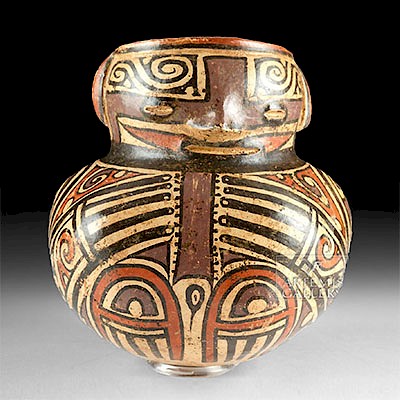Egyptian Gilded / Painted Wood Mummy Mask
Lot 1
About Seller
Artemis Fine Arts
686 S Taylor Ave, Ste 106
Louisville, CO 80027
United States
Selling antiquities, ancient and ethnographic art online since 1993, Artemis Gallery specializes in Classical Antiquities (Egyptian, Greek, Roman, Near Eastern), Asian, Pre-Columbian, African / Tribal / Oceanographic art. Our extensive inventory includes pottery, stone, metal, wood, glass and textil...Read more
Estimate:
$3,000 - $4,000
Absentee vs Live bid
Two ways to bid:
- Leave a max absentee bid and the platform will bid on your behalf up to your maximum bid during the live auction.
- Bid live during the auction and your bids will be submitted real-time to the auctioneer.
Bid Increments
| Price | Bid Increment |
|---|---|
| $0 | $25 |
| $300 | $50 |
| $1,000 | $100 |
| $2,000 | $250 |
| $5,000 | $500 |
| $10,000 | $1,000 |
| $20,000 | $2,500 |
| $50,000 | $5,000 |
| $100,000 | $10,000 |
| $200,000 | $20,000 |
About Auction
By Artemis Fine Arts
Nov 8, 2018
Set Reminder
2018-11-08 10:00:00
2018-11-08 10:00:00
America/New_York
Bidsquare
Bidsquare : Ancient / Ethnographic From Around The World
https://www.bidsquare.com/auctions/artemis-gallery/ancient-ethnographic-from-around-the-world-3598
Ancient art from Egypt, Greece, Italy and the Near East, as well as Asian, Pre-Columbian, Native American, African / Tribal / Oceanic, Spanish Colonial, Russian Icons, Fine art, much more! Artemis Fine Arts info@artemisgallery.com
Ancient art from Egypt, Greece, Italy and the Near East, as well as Asian, Pre-Columbian, Native American, African / Tribal / Oceanic, Spanish Colonial, Russian Icons, Fine art, much more! Artemis Fine Arts info@artemisgallery.com
- Lot Description
Ancient Egypt, Ptolemaic, ca. 305 to 30 BCE. A carved wooden mummy mask with a gilded face and painted gesso details. Crowned by a prominent headdress painted with horizontal bands of black, wine red, sky blue, and golden yellow hues and vertical black and gold bands down the center, the mesmerizing visage presents characteristically huge almond-shaped eyes, painted white and outlined in heavy black pigment with thick eyebrows above; an aquiline nose, a softly rounded chin and cheeks, pursed red-lips, and a black false beard. The verso presents several drilled dowel holes with fragments of wooden dowels still within. Size: 6.6" W x 8.75" H (16.8 cm x 22.2 cm); 9.625" H (24.4 cm) on included custom stand.
The mask was an essential part of the mummy, placed over the head to provide an idealized image of the deceased as he or she would be resurrected. This mask and others like it were traditionally carved from cedar. Interestingly, cedar wood was not native to Egypt. Egypt did not have verdant forests filled with tall trees, and unfortunately most of its native lumber was of relatively poor quality. So the ancient Egyptians relied on importing to acquire hardwoods - ebony imported from Africa, cedar and pine from Lebanon. One fabulous obelisk inscription by Thutmose III attests to the luxury of treasured hardwoods. It reads as follows, "They brought to me the choicest products . . . consisting of cedar, juniper and of meru wood . . . all the good sweet woods of God's Land." (Obelisk inscription by Thutmose III - J. H. Breasted, Ancient Records of Egypt, Part Two, p. 321)
Ancient Egyptians believed it was of the utmost importance to preserve a body of the deceased, because the soul needed a place to reside after the death. Preservation of the body was done via mummification - a process involving the removal of internal organs that were placed in canopic jars, wrapping body in linen, and then embalming. Death masks like this example were created so that the soul could recognize the body and return to it. For this reason, death masks were made in the likeness of the deceased. Artisans used different materials. Earlier masks were carved from wood, while later ones were made of cartonnage, a material made from papyrus or linen and soaked in plaster which was then applied to a wooden mold, was used. Royal death masks, perhaps the most famous being that of Tutankhamen, were made from precious metals. All death masks were intended to resemble the deceased subject; however, eyes were always slightly enlarged and lips presented in a subtle smile, as we see in this example.
Provenance: private East Coast, USA collection; ex-collection of Dr. Vladimir Piskacek, New York, USA, purchased in the 1970's
All items legal to buy/sell under U.S. Statute covering cultural patrimony Code 2600, CHAPTER 14, and are guaranteed to be as described or your money back.
A Certificate of Authenticity will accompany all winning bids.
We ship worldwide and handle all shipping in-house for your convenience.
#133216Surface wear commensurate with age with some repainting. Losses to peripheries as shown, but generally very good. Nice sections of wooden dowels remain in perforations on verso. A few smaller perforations to wood on verso; the wood has aged gracefully. There is a small metal insert for fitting the mask to its stand.Condition
- Shipping Info
-
All shipping is handled in-house for your convenience. Your invoice from Artemis Gallery will include shipping calculation instructions. If in doubt, please inquire BEFORE bidding for estimated shipping costs for individual items.
-
- Buyer's Premium



 EUR
EUR CAD
CAD AUD
AUD GBP
GBP MXN
MXN HKD
HKD CNY
CNY MYR
MYR SEK
SEK SGD
SGD CHF
CHF THB
THB














